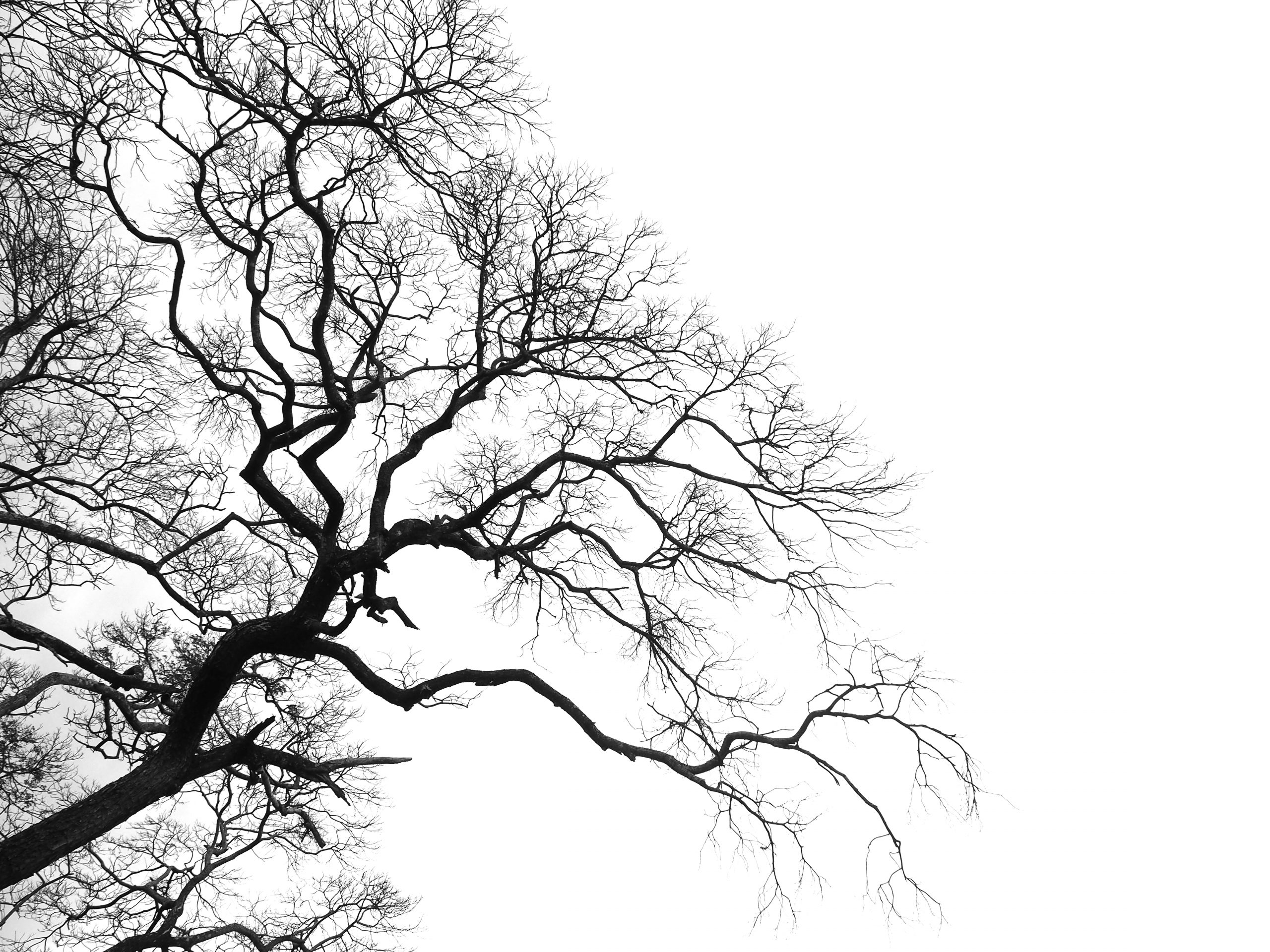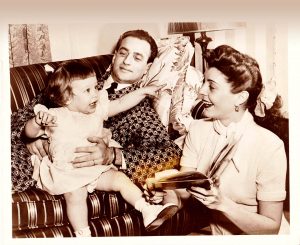
Saving George
An anchor of enchantment in the front yard
By Jim Dodson
His name is George. That’s what we’ve taken to calling him, at any rate. He’s old and bent with age, probably close to 100.
I’ve known him most of my life. But I never heard him speak until recently.
George is an old tree, Crataegus phaenopyrum — or so we think — based purely by his leaf pattern and bark. His common name is a Washington hawthorn — hence the nickname we’ve bestowed on him.
But George remains one sweet mystery.
According to my tree identification book, Washington hawthorns are relatively small flowering trees — in many cases shrubs — that produce early and abundant white flowers in the spring and vivid red berries that last into winter, a bounty for winter birds, especially cedar waxwings. They’re also reportedly poisonous to dogs, which could be a problem since Ajax, our shameless golden retriever, will eat anything put before him. On the other hand, he’s one lazy brute — the reason I call him “Junior” — and not much for climbing trees. So Junior is probably safe.
Besides, by my reckoning, George is at least 80 feet tall with a huge wingspan of limbs that are oddly free of red berries. We noticed this when he shed the last of his arrestingly gold and crimson leaves one cold and rainy Saturday in early December. One theory we’re floating is that George is possibly so elderly that he — or she, a potential Martha? — doesn’t produce berries anymore, an old story in the cycle of life. In any case, we’re likely to know more when spring returns.
The more immediate problem after that rainy Saturday was to get after the jungle of English ivy and wisteria vines that had nearly swallowed George whole. Some of the vines were as thick as wrists, wrapping insidiously around his limbs and into every crook and cranny of the noble old tree. With ladders, handsaw and a sharpened hatchet, I spent two full afternoons hacking down those wretched vines, cursing whatever fool thought it was a good idea to bring English ivy to America and put wisteria at the base of a tree.
George has stood at the edge of the Corry property for as long as I can recall, leaning gracefully over Dogwood Drive in a neighborhood famous for its hardwoods. When I was a boy, the Corry house was my favorite house in the neighborhood, just two doors away from my childhood home. The Corry boys, Craig, Chris and Britt, were pals and their mom and dad, Merle and Big Al, were some of my parents’ closest friends. Al was one of Greensboro’s top homebuilders. The Corry house was his dream house, built in 1951, one of the first houses built in the neighborhood. Dogwood Drive, I’ve learned from old aerial photos of the neighborhood, once ended at the edge of the yard where old George stands.
As I say, I’ve always loved the Corry house. It is spacious and quiet, a large handmade bungalow that flows elegantly from room to room, with parquet flooring and cool retro windows that open on sliders, the home of a craftsman.
Perhaps this explains why, after almost 40 years away, when my wife, Wendy, and I began scouting around my old neighborhood to buy a house, it seemed almost unimaginable and downright providential that the Corry house would be up for sale — just waiting for us to show up and buy it.
Merle and Big Al would be pleased by this sweet development. The four grown Corry kids certainly were. Each one got in touch to offer their enthusiastic congratulations when the news got out. The Corry family was the most self-sufficient clan I’ve ever known, natural builders and people full of life. Al was one of Greensboro’s great post-war homebuilders. Chris, the oldest boy, actually lived in a teepee with his bride as they built their own dream home west of Greensboro. The Corry boys hunted, fished and could build anything with their hands. They were also crazily musical, playing stringed instruments of every sort. In 1969, son Craig and I made the Greensboro Teenage Talent Show playing guitars and singing Bob Dylan’s “Don’t think Twice.” We called ourselves Alfred and James, a name we probably should have thought twice about.
Big Al informed us that Alfred and James needed something “extra” to win. “You boys need a schtick to impress the judges,” he advised.
I asked him why on earth we needed a stick on stage.
Big Al laughed. He hailed from the far north, Buffalo, NY. “That’s a Yiddish word,” he explained. “It means a comic gimmick, something to make people laugh. First rule of Vaudeville — always leave ’em laughing.”
He suggested using kazoos as we played. We thought it was lunacy until Mama Merle purchased us a couple of kazoos and we gave them a try.
The director of the show asked us to play a second song while the judges made up their minds. We wound up in third place, as I recall — losing to a teenage tap dancer and a pint-sized piano impresario — but Lee Kinard invited Alfred and James to perform on his Good Morning Show at Christmas. We worked up a couple Christmas carols and did the second one with kazoos. The kazoos were a big hit.
For a while, we played garden clubs and Kiwanis luncheons all over the Gate City. Everyone asked for the kazoos, our big finish.
* * *
But back go George.
It’s my hope that this old tree has many more happy years anchoring the Dodson front yard. Though dogwoods and ancient oaks and maples abound, George is still the most striking tree on the street, leaning gracefully over passersby like an elder gent tipping his hat.
Freeing the old fella from those horrible vines was no easy task. But I relished the job, alarming my wife from 15 feet up a ladder, hacking and sawing like I was trying to liberate an enchanted tree.
Whatever species he turns out to be, George is undoubtedly enchanted. All trees are. They speak a language all their own — or so I learned early as a boy who could never stay out of them.
One of my first memories of life is of sitting in a huge old tree by Greenfield Lake in Wilmington, waiting for my father to come home from the newspaper where he worked, taking in the natural world below.
For my Eagle Scout project a decade later, I carved a nature walk through the patch of woods beside my elementary school in Greensboro. Not long ago I went back to see if any traces of my work were still visible. The signs identifying plants were long gone but the trail was still there, overarched by glorious trees. I felt like a kid again.
In Maine, I helped build my own post and beam house in a forest of birch and hemlock from rough-sawn northern fir, with oak floors that came from from a 200-year-old barn. On cold but sunny winter days, whenever the afternoon sun streamed through that house’s windows and warmed the wood, you could hear gentle sighs and faint cracking sounds as the timbers of our house relaxed, expanded, exhaled.
The books I loved most as a kid all had enchanted trees in them. Plato and the ancient Greeks believed souls resided in sacred groves of trees, and the Buddha found enlightenment sitting beneath a fig. The Egyptian Book of the Dead mentions groves of sycamores where the departed find eternal bliss, and the Bible speaks of a Tree of Knowledge that altered paradise. The Irish word “druid” derives from a Celtic word for oak, while in India to this day people seeking miracles hang family rags on trees to make them shrines to the gods. My Baptist grandmother always insisted that the dogwood tree with its perfect white petals and crimson hearts was a symbol of Christ’s resurrection, and showed me the old Appalachian story to prove it.
The Glastonbury Throne, holds English lore, is a hawthorn tree that is said to have sprouted miraculously from the staff of Joseph of Arimathea when he brought Mary Magdalene to Britain after Jesus’ crucifixion. The Glastonbury hawthorn blooms at Christmas, and the Queen is traditionally brought one of its blooms with her tea on Christmas morning. In broader English lore, wherever hawthorns and oaks reside together, kindly fairies supposedly reside.
A mature tree, the ancients believed, is a perfect symbol of life and home because it reaches in all directions, limbs spreading to heaven and every compass point, anchored by unseen roots burrowing beneath the surface of the world.
We humans are anchored by unseen roots, too.
Mine are going here, into this familiar ground, for good.
As for George, who seems relieved to be free from his shackles of vines, the mystery of his identity was finally solved during our first Christmas Day in the Corry house when a close friend who happens to be a forester dropped by in the afternoon with his wife for coffee and the last of the apple pie. I pointed to George — adorned with his first shining Moravian star — and wondered why there are no red berries for the winter birds on our beautiful old Washington hawthorn.
Joe the forester merely smiled.
“That’s because George is actually an old sugar maple tree.”
What a lovely and unexpected gift for a new year.





